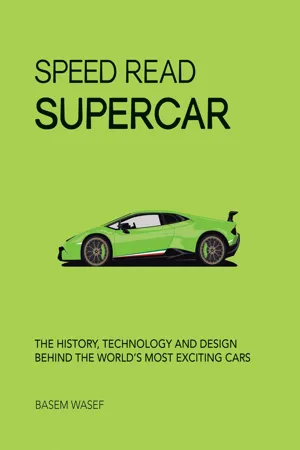
Speed Read Supercar
The History, Technology and Design Behind the World's Most Exciting Cars
- 160 pages
- English
- ePUB (mobile friendly)
- Available on iOS & Android
Speed Read Supercar
The History, Technology and Design Behind the World's Most Exciting Cars
About This Book
From Motorbooks' beautifully designed and illustrated Speed Read series, Speed Read Supercar guides you through every aspect of these imagination-capturing, eye-widening, land-bound speed missiles. When Lamborghini unleashed its Miura on an unsuspecting world in 1966, it set off a high-performance arms race that continues to this day. Ferrari, Maserati, Jaguar, Porsche, and Lotus all accepted the challenge. Over the following five decades, numerous others stepped up, including stalwarts like Aston Martin, BMW, and Audi, as well as small-volume specialists such as Koenigsegg, Pagani, Noble, and Spyker. The result is a veritable smorgasbord of blazingly fast and delicious-looking land missiles available to anyone with several hundred thousand dollars to spare. Supercars are complex subjects that interest nearly everyone. Every part of a supercar represents myriad decisions informed by engineering, aesthetics, human interface, and emotion. Speed Read Supercar answers the hows and whys of these fantastic cars in sections divided by topic, offering an engaging review of history, engineering, design, key concepts, and key people. Each section ends with a glossary of related terms, and informational sidebars provide fun facts, historical tidbits, and mini-bios of key people in the supercar world. Sleek illustrations showcase the incredible designs. With Motorbooks' Speed Read series, become an instant expert in a range of fast-moving subjects, from Formula 1 racing to the Tour de France. Accessible language, compartmentalized sections, fact-filled sidebars, glossaries of key terms, and event timelines deliver quick access to insider knowledge. Their brightly colored covers, modern design, pop art–inspired illustrations, and handy size make them perfect on-the-go reads.
Frequently asked questions
Information
THE GROUNDBREAKERS

THE GROUNDBREAKERS
MERCEDES-BENZ 300 SL “GULLWING”

THE GROUNDBREAKERS
FERRARI 250 GTO

THE GROUNDBREAKERS
FORD GT40
Table of contents
- Cover
- Title Page
- Contents
- Introduction
- Section 1 Groundbreakers
- Section 2 Eye for Design
- Section 3 1980s Renaissance
- Section 4 Tech Revolution
- Section 5 Modern Milestones
- Section 6 Sacred Ground
- Section 7 Indie Spirit
- Index
- Copyright